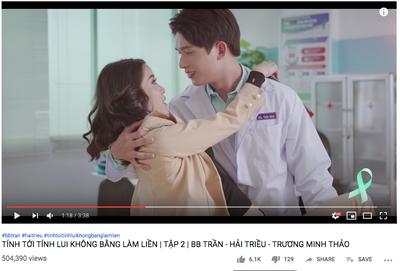Cervical cancer is now “cracking you up”.
- Trang Nguyen

- Aug 20, 2019
- 4 min read
How is it able to crack me up?
Whenever one hears the word “cancer", there comes an invisible fear of coming to a dead-end and getting cracked up. In 2018, Vietnam’s cancer mortality number is reported as more than 114,000, among which 2,420 cases were caused by cervical/cervix uteri cancer (Globocan, 2018). Consequently, its patients suffer from severe consequences such as declining health, risk of infertility, financial depletion and other mental effects for one’s self and their family.

To raise awareness about HPV virus, the main cause of cervical cancer, and its prevention, Vietnam Association of Preventive Medicine (VAPM) released a Youtube webisode series named “Tính tới tính lui không bằng làm liền” (relatively translated as “Do it now rather than thinking back and forth”) in April, 2019, to educate young people, especially teenage girls about HPV vaccination. The series consists of three webisodes, only around five minutes each but they have received millions of views and positive comments on the creative idea of the campaign.
Link to webisodes: https://www.youtube.com/watch?v=1N4rT34iMGc&list=PLkzuNOwS2ZeuwfLcIrq3EQnFWPT8kK8Uk
The main plot simply tells a story about a group of three young and beautiful girls, resembling three different lifestyles of modern women:
Ky Duyen- a naive girl seeking for a prince and a pink life,
Huyen My- a work-aholic who is ambitious for her success, and
Tieu Vi- an energetic explorer who is always ready for new adventures.
A so-called “war” occurs when they all fall in love at first sight with the handsome doctor- Thai Bao. More exceptionally, the comedy series invites BB Tran and Hai Trieu, two Vietnamese comedians famous for their gracefulness in acting as female characters, to play the roles of the nurses in Dr. Thai Bao’s clinique. It seems like a comedy about several girls fighting for the heart of one boy until the message of HPV vaccine is inserted brilliantly. The three girls, in the end, all fail as the doctor is taken already, but are then taken away and given the vaccination by the two nurses. Netizens give the twin nurses precious compliments for being gracefully sarcastic but still able to remind the audience to take the vaccine. The webisodes are meant to educate people about the importance of preventing cancer - a hair-raising term to think of - but in a very funny and intimate way. Therefore, it makes the audience somewhat less scared of being cracked up by cancer, and more satisfied to let the comedy crack them up!
A new approach to Vietnamese health education.
Youtube is the right choice.
According to Professor Cao Huu Nghia (cited in HPV.vn, 2019), from Pasteur Institute, Ho Chi Minh city, HPV vaccine is the fastest and most effective method to prevent cervical cancer for girls from 9-26 years old. Knowing the age group is quite big, the campaign mainly focuses on the latter group of ‘older-than-18’ female adults, whose 84% rely on social media to get news at least once a day (Pew Research Center, 2018). Q&Me (2017) also revealed that Youtube significantly gathered popularity among 18-24 age group. That is to say choosing Youtube as the main platform for this project is cleverly reasonable.
Health education is made less boring.
Since this is a social campaign aiming at enhancing people’s awareness of healthcare, under surveillance of such a strict national association as VAPM, doing everything with high scientific standards yet earning exceptional popularity is a real challenge for any agency. Ha (2019), Campaign Account Executive, shares that it is crucial to step into young girls’ minds, read their stories and try to make the behavior arrive in their natural sense. Seeing the fact that the printed banners, posters on the street, in the hospitals are unappealing and not really working for these youthful minds, they came up with a new approach for HPV vaccination: short videos with humor appeal. Petrovska et al. (2016) discuss that if the content is humorous, the message may lead to persuasion and positive mood of the viewers.

The two actors BB Tran and Hai Trieu, who have millions of fans on their social media platforms, contribute to the amazing effect by adding their unique acting style and languages that young netizens are so familiar with. In addition, the webisodes are posted on BB Tran’s youtube channel and attract young customers who are more than eager to watch a comedy of him, without actual consideration of the health alert from VAPM. By observing the audience's reactions to the webisodes, it is very promising that viewers enjoy the video so much that they forget those are a healthcare campaign. The message is delivered smoothly and efficiently as they make the audience laugh, think and relate.
Is this humor approach suitable for every advertising campaign?
The answer is “NO”.
It has to be admitted that using humor elements too much can cause shallowness in transmitting the intention of the marketer. Kuilenburg et al. (cited in Petrovska et al. 2016) figure out that viewers’ attention would be only at the laugh-able parts, not on the brand name or message when humor missed out the relation with the brand. Otherwise, it could be a disaster that destroys the brand if humor appeared as offensive or of sensitive subjects. Humor is then clearly not humorous anymore if the joke affects political issues, isn’t it?
Therefore, while doing advertising campaign, especially in countries with various ethical rules and fine customs to consider, agencies should have clear research about the market, speak the audience’s language but in a selected way to prevent side effects. You might dream of doing a campaign that makes people laugh and remember, not just a tickle in the belly!
References:
Globocan (2018), Vietnam cancer fact sheets, viewed May 2019, <https://gco.iarc.fr/today/data/factsheets/populations/704-viet-nam-fact-sheets.pdf>
HPV.vn (2019), Sao Việt và cộng đồng mạng “gây sốt” với avatar xanh ngọc nhân ngày của mẹ, viewed 2 Mar, 2019, <http://www.hpv.vn/sao-viet-va-cong-dong-mang-gay-sot-voi-avatar-xanh-ngoc-nhan-ngay-cua-me>
Pew Research Center (2018), Young people tend to be more avid online news users, Spring 2017 Global Attitudes Survey, viewed 9 Jan 2018 <https://www.pewresearch.org/global/2018/01/11/publics-globally-want-unbiased-news-coverage-but-are-divided-on-whether-their-news-media-deliver/pg_2018-01-11_global-media-habits_0-05/>
Q&Me (2017), Vietnam mobile application popularity and user analysis, Slide Share, p.6, viewed 14 Dec 2017, <https://www.slideshare.net/asiaplus_inc/vietnam-mobile-application-popularity-and-user-analysis>
Ha, K. (2019), Kỳ 7: Tụi em bán vắc-xin, chị hiểu hông?, podcast, Meomeotalks, viewed 5 Jun 2019, <https://soundcloud.com/meomeotalks/ky-7-tui-em-ban-vac-xin-chi-hieu-hong>
Petrovska, I et al. (2016), Is Humor Advertising Always Effective? Parameters for Effective Use of Humor in Advertising, Journal of Management Research, ISSN 1941-899X 2016, Vol. 8, No. 1, pp.5-6, viewed 1 Jan 2016, <https://pdfs.semanticscholar.org/a49a/db5186bfc6a29cf143d70f955741c7789547.pdf









Comments